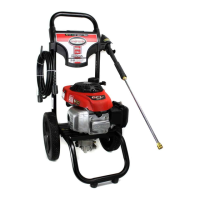
Do you have a question about the Simpson MSV3024 and is the answer not in the manual?
| Brand | Simpson |
|---|---|
| Model | MSV3024 |
| Category | Pressure Washer |
| Language | English |
Engine exhaust contains deadly carbon monoxide. Use outdoors only.
Read manuals and contact customer service if unsure.
Keep clear of nozzle; do not direct stream at people or animals.
Gasoline vapors can ignite. Prevent spills and store fuel properly.
Prevent overheating by ensuring adequate ventilation and clearance.
Secure fuel properly to prevent access by children or accidental ignition.
Avoid using acids, solvents, or poisons with the pressure washer.
Engine exhaust contains deadly CO gas. Operate in well-ventilated areas.
Some fluids can injure skin, eyes, or lungs. Use recommended fluids.
High-pressure spray can penetrate flesh. Do not treat as a cut; seek medical help.
Inspect hoses for damage. Do not grasp leaking hoses or place hands in front of nozzle.
Relieve system pressure before maintenance to prevent injury.
Spray can break objects or cause projectiles. Wear safety glasses.
Operate alertly, avoid fatigue and alcohol. Do not use damaged parts.
Keep spray away from electrical outlets and connected objects.
Use recommended cleaners only. Wear protective clothing.
Follow warnings for fuel, ventilation, hose contact, and water supply.
Start engine, depress trigger for water flow, grip wand firmly.
Consult engine manual. Pump is maintenance-free; check connections.
Solutions for common issues like no fuel, incorrect choke, or detached spark plug wire.
Addresses low pressure due to choke, spark plug, water supply, leaks, or clogged nozzles.
